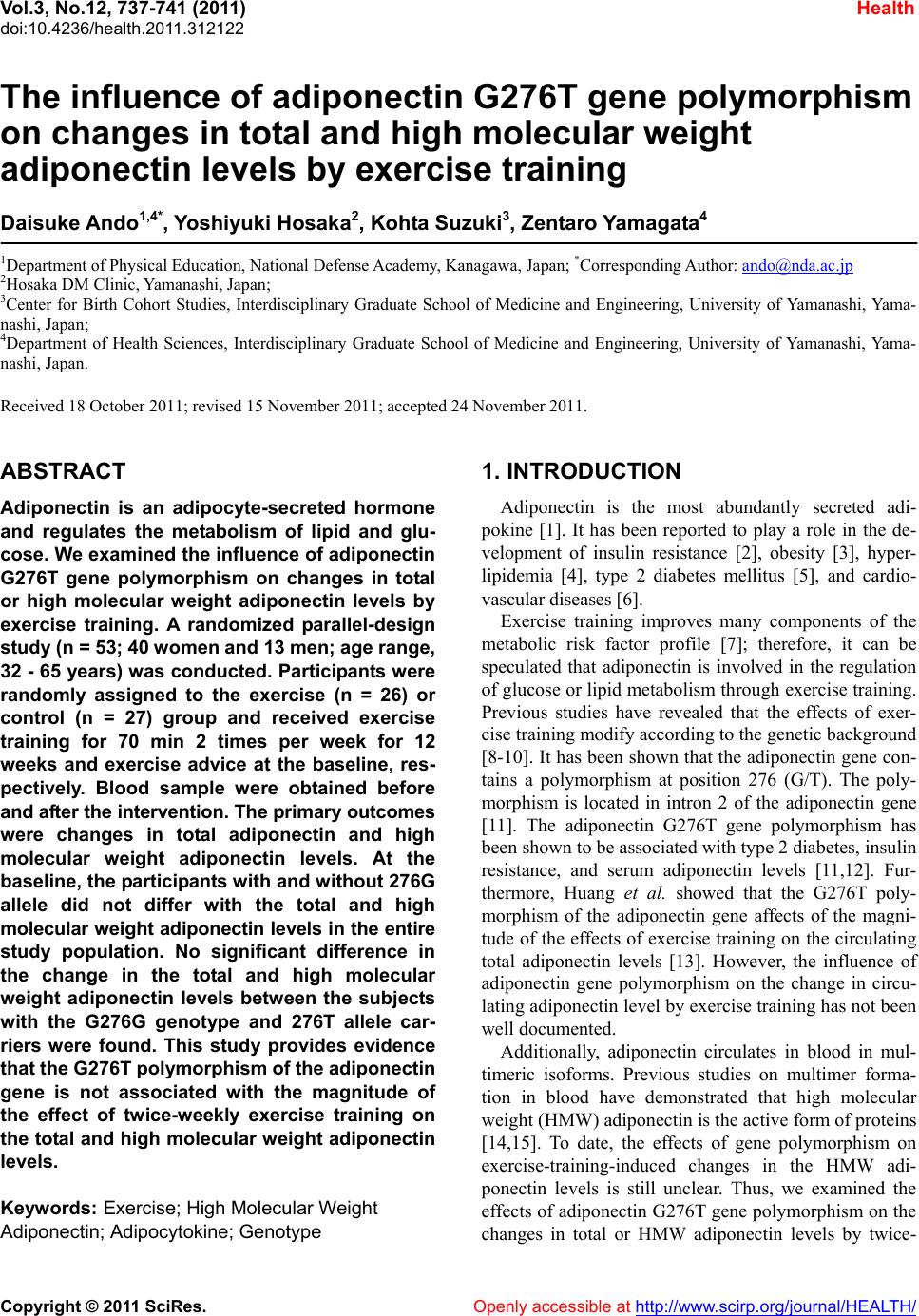 Vol.3, No.12, 737-741 (2011) doi:10.4236/health.2011.312122 C opyright © 2011 SciRes. Openly accessible at http://www.scirp.org/journal/HEALTH/ Health The influence of adiponectin G276T gene polymorphism on changes in total and high molecular weight adiponectin levels by exercise training Daisuke Ando1,4*, Yo shiyuki Hosaka2, Kohta Suzuki3, Zentaro Yamagata4 1Department of Physical Education, National Defense Academy, Kanagawa, Japan; *Corresponding Author: ando@nda.ac.jp 2Hosaka DM Clinic, Yamanashi, Japan; 3Center for Birth Cohort Studies, Interdisciplinary Graduate School of Medicine and Engineering, University of Yamanashi, Yama- nashi, Japan; 4Department of Health Sciences, Interdisciplinary Graduate School of Medicine and Engineering, University of Yamanashi, Yama- nashi, Japan. Received 18 October 2011; revised 15 November 2011; accepted 24 November 2011. ABSTRACT Adiponectin is an adipocyte-secreted hormone and regulates the metabolism of lipid and glu- cose. We examined the influence of adiponectin G276T gene polymorphism on changes in total or high molecular weight adiponectin levels by exercise training. A randomized parallel-design study (n = 53; 40 women and 13 men; age range, 32 - 65 years) was conducted. Participants were randomly assigned to the exercise (n = 26) or control (n = 27) group and received exercise training for 70 min 2 times per week for 12 weeks and exercise advice at the baseline, res- pectively. Blood sample were obtained before and after the intervention. The primary outcomes were changes in total adiponectin and high molecular weight adiponectin levels. At the baseline, the participants with and without 276G allele did not differ with the total and high molecular weight ad iponectin levels in the entire study population. No significant difference in the change in the total and high molecular weight adiponectin levels between the subjects with the G276G genotype and 276T allele car- riers were found. This study provides evidence that the G276T poly morphism of the ad iponectin gene is not associated with the magnitude of the effect of twice-weekly exercise training on the total and high molecular weight adiponectin levels. Keywords: Exercise; High Molecular Weight Adiponectin; Adipocytokine; Genotype 1. INTRODUCTION Adiponectin is the most abundantly secreted adi- pokine [1]. It has been reported to play a role in the de- velopment of insulin resistance [2], obesity [3], hyper- lipidemia [4], type 2 diabetes mellitus [5], and cardio- vascular diseases [6]. Exercise training improves many components of the metabolic risk factor profile [7]; therefore, it can be speculated that adiponectin is involved in the regulation of glucose or lipid metabolism through exercise training. Previous studies have revealed that the effects of exer- cise training modify according to the genetic background [8-10]. It has been shown that the adiponectin gene con- tains a polymorphism at position 276 (G/T). The poly- morphism is located in intron 2 of the adiponectin gene [11]. The adiponectin G276T gene polymorphism has been shown to be associated with type 2 diabetes, insulin resistance, and serum adiponectin levels [11,12]. Fur- thermore, Huang et al. showed that the G276T poly- morphism of the adiponectin gene affects of the magni- tude of the effects of exercise training on the circulating total adiponectin levels [13]. However, the influence of adiponectin gene polymorphism on the change in circu- lating adiponectin level by ex ercise training has no t been well documented. Additionally, adiponectin circulates in blood in mul- timeric isoforms. Previous studies on multimer forma- tion in blood have demonstrated that high molecular weight (HMW) adiponectin is the active form of proteins [14,15]. To date, the effects of gene polymorphism on exercise-training-induced changes in the HMW adi- ponectin levels is still unclear. Thus, we examined the effects of adiponectin G276T gene polymorphism on the changes in total or HMW adiponectin levels by twice- 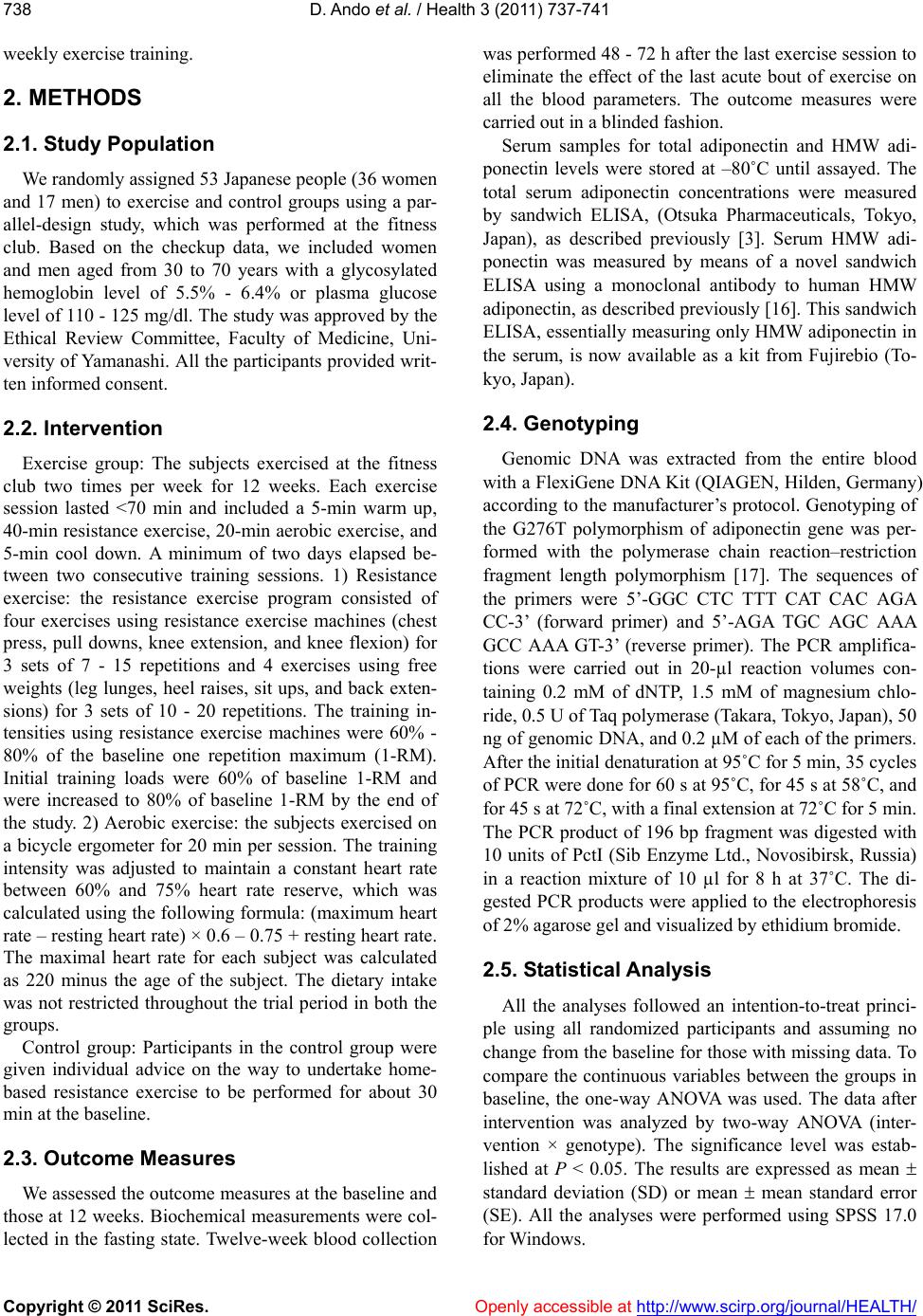 D. Ando et al. / Health 3 (2011) 737-741 Copyright © 2011 SciRes. Openly accessible at http:// www.scirp.org/journal/HEALTH/ 738 weekly exercise training. 2. METHODS 2.1. Stud y Population We randomly assigned 53 Japanese people (36 women and 17 men) to exercise and control groups using a par- allel-design study, which was performed at the fitness club. Based on the checkup data, we included women and men aged from 30 to 70 years with a glycosylated hemoglobin level of 5.5% - 6.4% or plasma glucose level of 110 - 125 mg/dl. The study was approved by the Ethical Review Committee, Faculty of Medicine, Uni- versity of Yamanashi. All the participants p rovided writ- ten informed consent. 2.2. Intervention Exercise group: The subjects exercised at the fitness club two times per week for 12 weeks. Each exercise session lasted <70 min and included a 5-min warm up, 40-min resistance exercise, 20-min aerobic exercise, and 5-min cool down. A minimum of two days elapsed be- tween two consecutive training sessions. 1) Resistance exercise: the resistance exercise program consisted of four exercises using resistance exercise machines (chest press, pull downs, knee extension, and knee flexion) for 3 sets of 7 - 15 repetitions and 4 exercises using free weights (leg lunges, heel raises, sit ups, and back exten- sions) for 3 sets of 10 - 20 repetitions. The training in- tensities using resistance exercise machines were 60% - 80% of the baseline one repetition maximum (1-RM). Initial training loads were 60% of baseline 1-RM and were increased to 80% of baseline 1-RM by the end of the study. 2) Aerobic exercise: the subjects exercised on a bicycle ergometer for 20 min per session. The training intensity was adjusted to maintain a constant heart rate between 60% and 75% heart rate reserve, which was calculated using the following formula: (maximum heart rate – resting heart rate) × 0.6 – 0.75 + resting heart rate. The maximal heart rate for each subject was calculated as 220 minus the age of the subject. The dietary intake was not restricted throughout the trial period in both the groups. Control group: Participants in the control group were given individual advice on the way to undertake home- based resistance exercise to be performed for about 30 min at the baseline. 2.3. Outcome Measures We assessed the outcome measures at the baseline and those at 12 weeks. Biochemical measurements were col- lected in the fasting state. Twelve-week blood collection was performed 48 - 72 h after the last exercise session to eliminate the effect of the last acute bout of exercise on all the blood parameters. The outcome measures were carried out in a blinded fashion . Serum samples for total adiponectin and HMW adi- ponectin levels were stored at –80˚C until assayed. The total serum adiponectin concentrations were measured by sandwich ELISA, (Otsuka Pharmaceuticals, Tokyo, Japan), as described previously [3]. Serum HMW adi- ponectin was measured by means of a novel sandwich ELISA using a monoclonal antibody to human HMW adiponectin, as described previously [16]. This sandwich ELISA, essentially measuring only HMW adiponectin in the serum, is now available as a kit from Fujirebio (To- kyo, Japan). 2.4. Genotyping Genomic DNA was extracted from the entire blood with a FlexiGene DNA Kit (Q IAGEN, Hild en, Germany) according to the manufacturer’s protocol. Genotyping of the G276T polymorphism of adiponectin gene was per- formed with the polymerase chain reaction–restriction fragment length polymorphism [17]. The sequences of the primers were 5’-GGC CTC TTT CAT CAC AGA CC-3’ (forward primer) and 5’-AGA TGC AGC AAA GCC AAA GT-3’ (reverse primer). The PCR amplifica- tions were carried out in 20-µl reaction volumes con- taining 0.2 mM of dNTP, 1.5 mM of magnesium chlo- ride, 0.5 U of Taq polymerase (Takara, Tokyo, Japan), 50 ng of genomic DNA, and 0.2 µM of each of the primers. After the initial denaturation at 95˚C for 5 min, 35 cycles of PCR were done for 60 s at 95˚C, for 45 s at 58˚C, and for 45 s at 72˚C, with a final extension at 72˚C for 5 min. The PCR product of 196 bp fragment was digested with 10 units of PctI (Sib Enzyme Ltd., Novosibirsk, Russia) in a reaction mixture of 10 µl for 8 h at 37˚C. The di- gested PCR products were applied to the electrophoresis of 2% agarose gel and visualized by ethidium bromide. 2.5. Statistical Analysis All the analyses followed an intention-to-treat princi- ple using all randomized participants and assuming no change from the baseline for those with missing data. To compare the continuous variables between the groups in baseline, the one-way ANOVA was used. The data after intervention was analyzed by two-way ANOVA (inter- vention × genotype). The significance level was estab- lished at P < 0.05. The results are expressed as mean standard deviation (SD) or mean mean standard error (SE). All the analyses were performed using SPSS 17.0 for W i ndows. 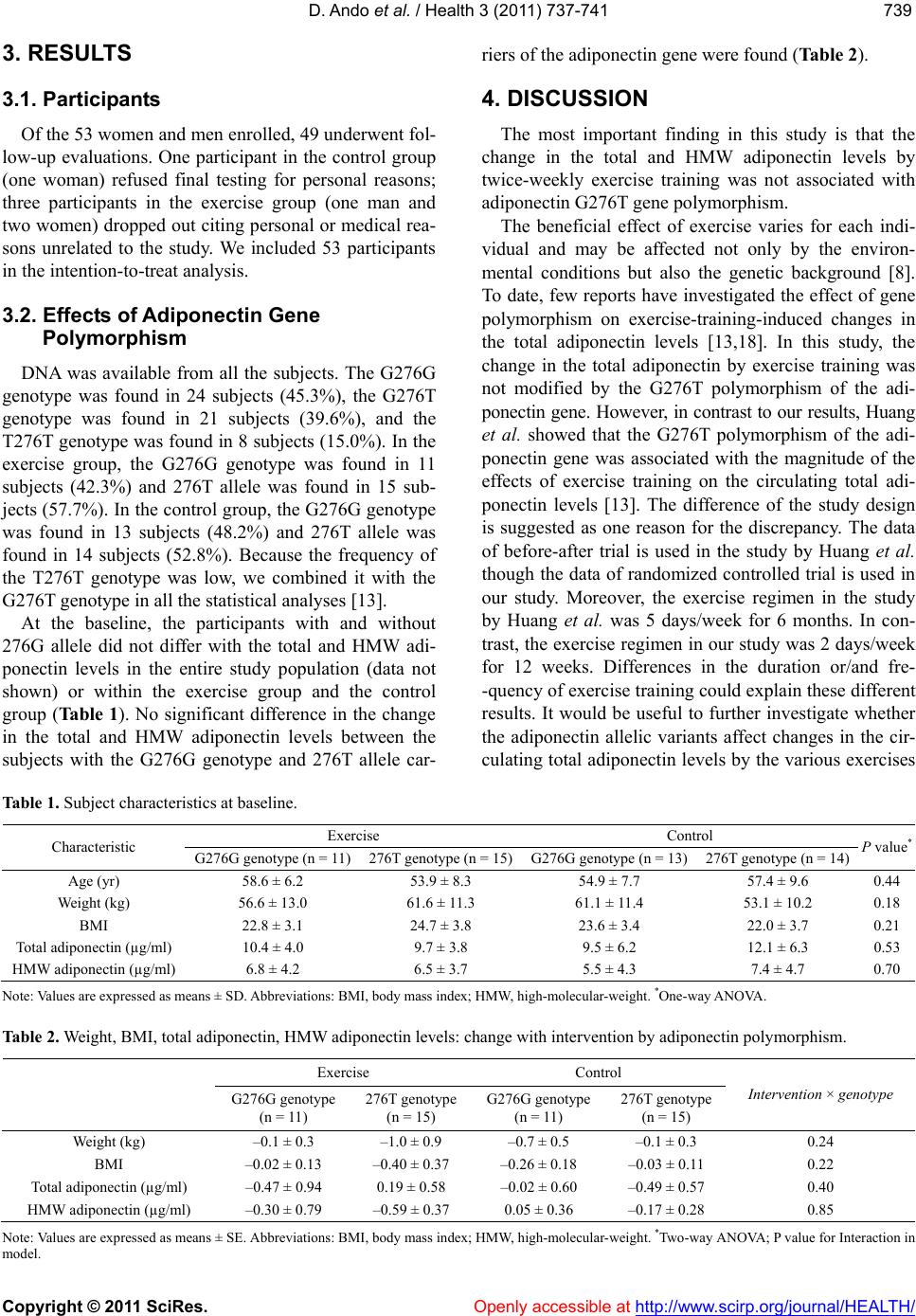 D. Ando et al. / Health 3 (2011) 737-741 Copyright © 2011 SciRes. http://www.scirp.org/journal/HEALTH/Openly accessible at 739739 3. RESULTS 3.1. Participants Of the 53 women and men enrolled, 49 underwent fol- low-up evaluations. One participant in the control group (one woman) refused final testing for personal reasons; three participants in the exercise group (one man and two women) dropped out citing personal o r medical rea- sons unrelated to the study. We included 53 participants in the intention-to-treat analysis. 3.2. Effects of Adiponectin Gene Polymorphism DNA was available from all the subjects. The G276G genotype was found in 24 subjects (45.3%), the G276T genotype was found in 21 subjects (39.6%), and the T276T genotype was found in 8 subjects (15.0%). In the exercise group, the G276G genotype was found in 11 subjects (42.3%) and 276T allele was found in 15 sub- jects (57.7%). In the contro l group, the G276G genotype was found in 13 subjects (48.2%) and 276T allele was found in 14 subjects (52.8%). Because the frequency of the T276T genotype was low, we combined it with the G276T genotype in all the statistical analyses [13]. At the baseline, the participants with and without 276G allele did not differ with the total and HMW adi- ponectin levels in the entire study population (data not shown) or within the exercise group and the control group (Tabl e 1). No significant difference in the change in the total and HMW adiponectin levels between the subjects with the G276G genotype and 276T allele car- riers of the adiponectin gene were found (Table 2). 4. DISCUSSION The most important finding in this study is that the change in the total and HMW adiponectin levels by twice-weekly exercise training was not associated with adiponectin G2 76 T gene polym orphi sm. The beneficial effect of exercise varies for each indi- vidual and may be affected not only by the environ- mental conditions but also the genetic background [8]. To date, few reports have investigated the effect of gene polymorphism on exercise-training-induced changes in the total adiponectin levels [13,18]. In this study, the change in the total adiponectin by exercise training was not modified by the G276T polymorphism of the adi- ponectin gene. However, in contrast to our results, Huang et al. showed that the G276T polymorphism of the adi- ponectin gene was associated with the magnitude of the effects of exercise training on the circulating total adi- ponectin levels [13]. The difference of the study design is suggested as one reason for the discrepancy. The data of before-after trial is used in the study by Huang et al. though the data of randomized controlled trial is used in our study. Moreover, the exercise regimen in the study by Huang et al. was 5 days/week for 6 months. In con- trast, the exercise regimen in our study was 2 days/week for 12 weeks. Differences in the duration or/and fre- -quency of exercise training could explain these different results. It would be useful to further investigate whether the adiponectin allelic variants affect changes in the cir- culating total ad iponectin levels by the various exercises Table 1. Subject characteristics at baseline. Exercise Control Characteristic G276G genotype (n = 11) 276T genotype (n = 15)G276G genotype (n = 13)276T genotype (n = 14)P value* Age (yr) 58.6 ± 6.2 53.9 ± 8.3 54.9 ± 7.7 57.4 ± 9.6 0.44 Weight (kg) 56.6 ± 13.0 61.6 ± 11.3 61.1 ± 11.4 53.1 ± 1 0.2 0.18 BMI 22.8 ± 3.1 24.7 ± 3.8 23.6 ± 3.4 22.0 ± 3.7 0.21 Total adiponectin (µg/ml) 10.4 ± 4.0 9.7 ± 3.8 9.5 ± 6.2 12.1 ± 6.3 0.53 HMW adiponecti n (µg/ml) 6.8 ± 4.2 6.5 ± 3.7 5.5 ± 4.3 7.4 ± 4.7 0.70 Note: Values are expressed as means ± SD. Abbreviations: BMI, body mass index; HMW, high-molecula r-weight. *One-way ANOVA. Table 2. Weight, BMI, total adiponectin, HMW adiponectin levels: change with intervention by adiponectin polymorphism. Exercise Control G276G genotype (n = 11) 276T geno type (n = 15) G276G genotype (n = 11) 276T geno type (n = 15) Intervention × genotype Weight (kg) –0.1 ± 0.3 –1.0 ± 0.9 –0.7 ± 0.5 –0.1 ± 0.3 0.24 BMI –0.02 ± 0.13 –0.40 ± 0.37 –0.26 ± 0.18 –0.03 ± 0.11 0.22 Total adiponectin (µg/ml) –0.47 ± 0.94 0.19 ± 0.58 –0.02 ± 0.60 –0.49 ± 0.57 0.40 HMW adiponecti n (µg/ml) –0.30 ± 0 .79 –0.59 ± 0.37 0.05 ± 0.36 –0.17 ± 0.28 0.85 Note: Values are expressed as means ± SE. Abbreviations: BMI, body mass index; HMW, high-molecular-weight. *Two-way ANOVA; P valu e f or In ter actio n in model. 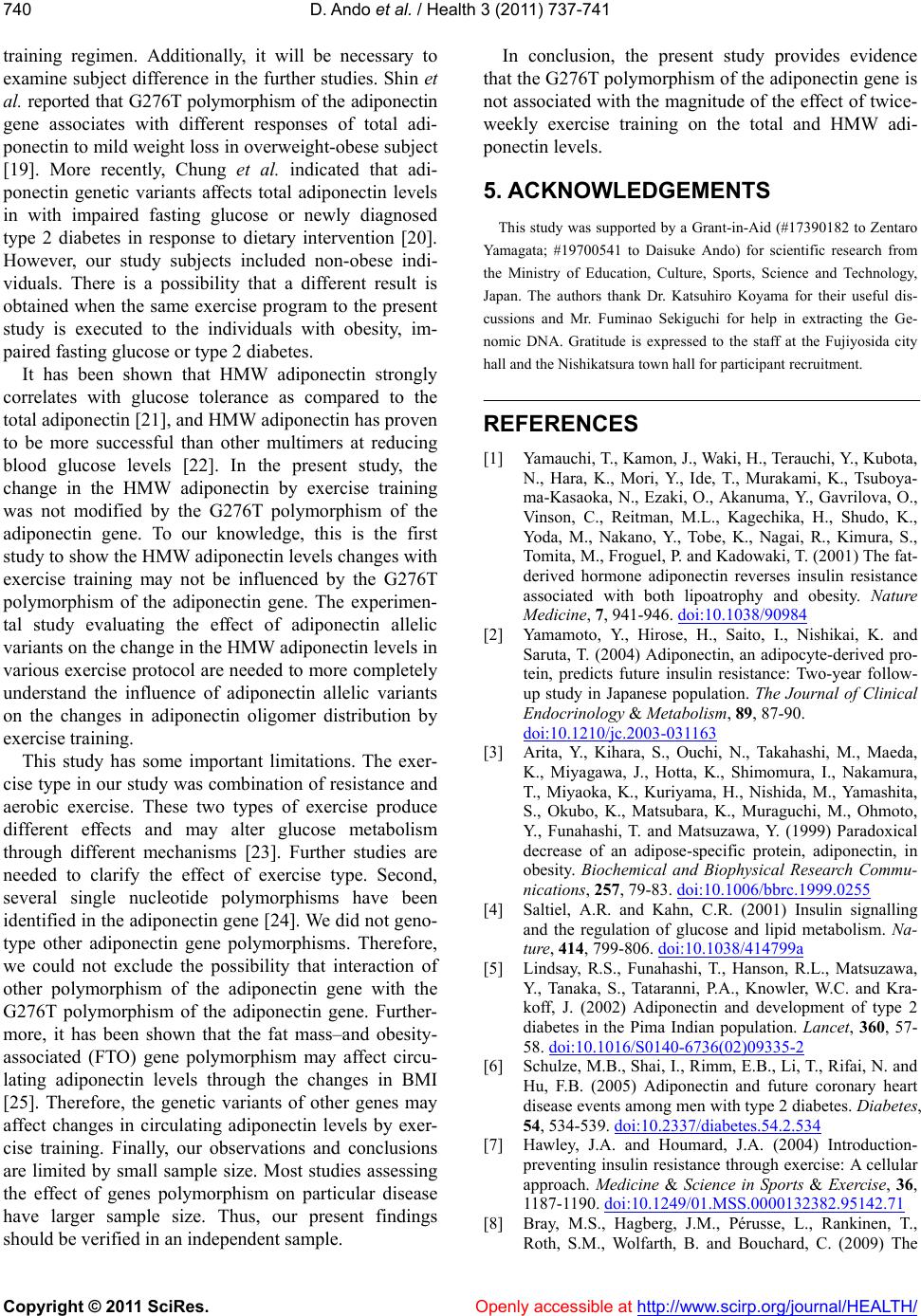 D. Ando et al. / Health 3 (2011) 737-741 Copyright © 2011 SciRes. Openly accessible at http:// www.scirp.org/journal/HEALTH/ 740 training regimen. Additionally, it will be necessary to examine subject difference in the further studies. Shin et al. reported that G276T polymorphism of the adiponectin gene associates with different responses of total adi- ponectin to mild weight loss in overweight-obese subject [19]. More recently, Chung et al. indicated that adi- ponectin genetic variants affects total adiponectin levels in with impaired fasting glucose or newly diagnosed type 2 diabetes in response to dietary intervention [20]. However, our study subjects included non-obese indi- viduals. There is a possibility that a different result is obtained when the same exercise program to the present study is executed to the individuals with obesity, im- paired fasting glucose or type 2 diabetes. It has been shown that HMW adiponectin strongly correlates with glucose tolerance as compared to the total adiponectin [21], and HMW adiponectin has proven to be more successful than other multimers at reducing blood glucose levels [22]. In the present study, the change in the HMW adiponectin by exercise training was not modified by the G276T polymorphism of the adiponectin gene. To our knowledge, this is the first study to show the HMW ad iponectin lev els changes with exercise training may not be influenced by the G276T polymorphism of the adiponectin gene. The experimen- tal study evaluating the effect of adiponectin allelic variants on the chan ge in the HMW adiponectin levels in various exercise protocol are needed to more completely understand the influence of adiponectin allelic variants on the changes in adiponectin oligomer distribution by exercise training. This study has some important limitations. The exer- cise type in our study was combination of resistance and aerobic exercise. These two types of exercise produce different effects and may alter glucose metabolism through different mechanisms [23]. Further studies are needed to clarify the effect of exercise type. Second, several single nucleotide polymorphisms have been identified in the adiponectin gen e [24]. We did not geno- type other adiponectin gene polymorphisms. Therefore, we could not exclude the possibility that interaction of other polymorphism of the adiponectin gene with the G276T polymorphism of the adiponectin gene. Further- more, it has been shown that the fat mass–and obesity- associated (FTO) gene polymorphism may affect circu- lating adiponectin levels through the changes in BMI [25]. Therefore, the genetic variants of other genes may affect changes in circulating adiponectin levels by exer- cise training. Finally, our observations and conclusions are limited by small sample size. Most studies assessing the effect of genes polymorphism on particular disease have larger sample size. Thus, our present findings should be verified in an independent sample. In conclusion, the present study provides evidence that the G276T polymorphism of the adiponectin g ene is not associated with the magnitude of the effect of twice- weekly exercise training on the total and HMW adi- ponectin levels. 5. ACKNOWLEDGEMENTS This study was supported by a Grant-in-Aid (#17390182 to Zentaro Yamagata; #19700541 to Daisuke Ando) for scientific research from the Ministry of Education, Culture, Sports, Science and Technology, Japan. The authors thank Dr. Katsuhiro Koyama for their useful dis- cussions and Mr. Fuminao Sekiguchi for help in extracting the Ge- nomic DNA. Gratitude is expressed to the staff at the Fujiyosida city hall and the Nishikatsura town hall for participant recruitment. REFERENCES [1] Yamauchi, T., Kamon, J., Waki, H., Terauchi, Y., Kubota, N., Hara, K., Mori, Y., Ide, T., Murakami, K., Tsuboya- ma-Kasaoka, N., Ezaki, O., Akanuma, Y., Gavrilova, O., Vinson, C., Reitman, M.L., Kagechika, H., Shudo, K., Yoda, M., Nakano, Y., Tobe, K., Nagai, R., Kimura, S., Tomita, M., Froguel, P. and Kadowaki, T. (2001) The fat- derived hormone adiponectin reverses insulin resistance associated with both lipoatrophy and obesity. Nature Medicine, 7, 941-946. doi:10.1038/90984 [2] Yamamoto, Y., Hirose, H., Saito, I., Nishikai, K. and Saruta, T. (2004) Adiponectin, an adipocyte-derived pro- tein, predicts future insulin resistance: Two-year follow- up study in Japanese population. The Journal of Clinical Endocrinology & Metabolism, 89, 87-90. doi:10.1210/jc.2003-031163 [3] Arita, Y., Kihara, S., Ouchi, N., Takahashi, M., Maeda, K., Miyagawa, J., Hotta, K., Shimomura, I., Nakamura, T., Miyaoka, K., Kuriyama, H., Nishida, M., Yamashita, S., Okubo, K., Matsubara, K., Muraguchi, M., Ohmoto, Y., Funahashi, T. and Matsuzawa, Y. (1999) Paradoxical decrease of an adipose-specific protein, adiponectin, in obesity. Biochemical and Biophysical Research Commu- nications, 257, 79-83. doi:10.1006/bbrc.1999.0255 [4] Saltiel, A.R. and Kahn, C.R. (2001) Insulin signalling and the regulation of glucose and lipid metabolism. Na- ture, 414, 799-806. doi:10.1038/414799a [5] Lindsay, R.S., Funahashi, T., Hanson, R.L., Matsuzawa, Y., Tanaka, S., Tataranni, P.A., Knowler, W.C. and Kra- koff, J. (2002) Adiponectin and development of type 2 diabetes in the Pima Indian population. Lancet, 360, 57- 58. doi:10.1016/S0140-6736(02)09335-2 [6] Schulze, M.B., Shai, I., Rimm, E.B., Li, T., Rifai, N. and Hu, F.B. (2005) Adiponectin and future coronary heart disease events among men with ty pe 2 diabetes. Diabetes, 54, 534-539. doi:10.2337/diabetes.54.2.534 [7] Hawley, J.A. and Houmard, J.A. (2004) Introduction- preventing insulin resistance through exercise: A cellular approach. Medicine & Science in Sports & Exercise, 36, 1187-1190. doi:10.1249/01.MSS.0000132382.95142.71 [8] Bray, M.S., Hagberg, J.M., Pérusse, L., Rankinen, T., Roth, S.M., Wolfarth, B. and Bouchard, C. (2009) The 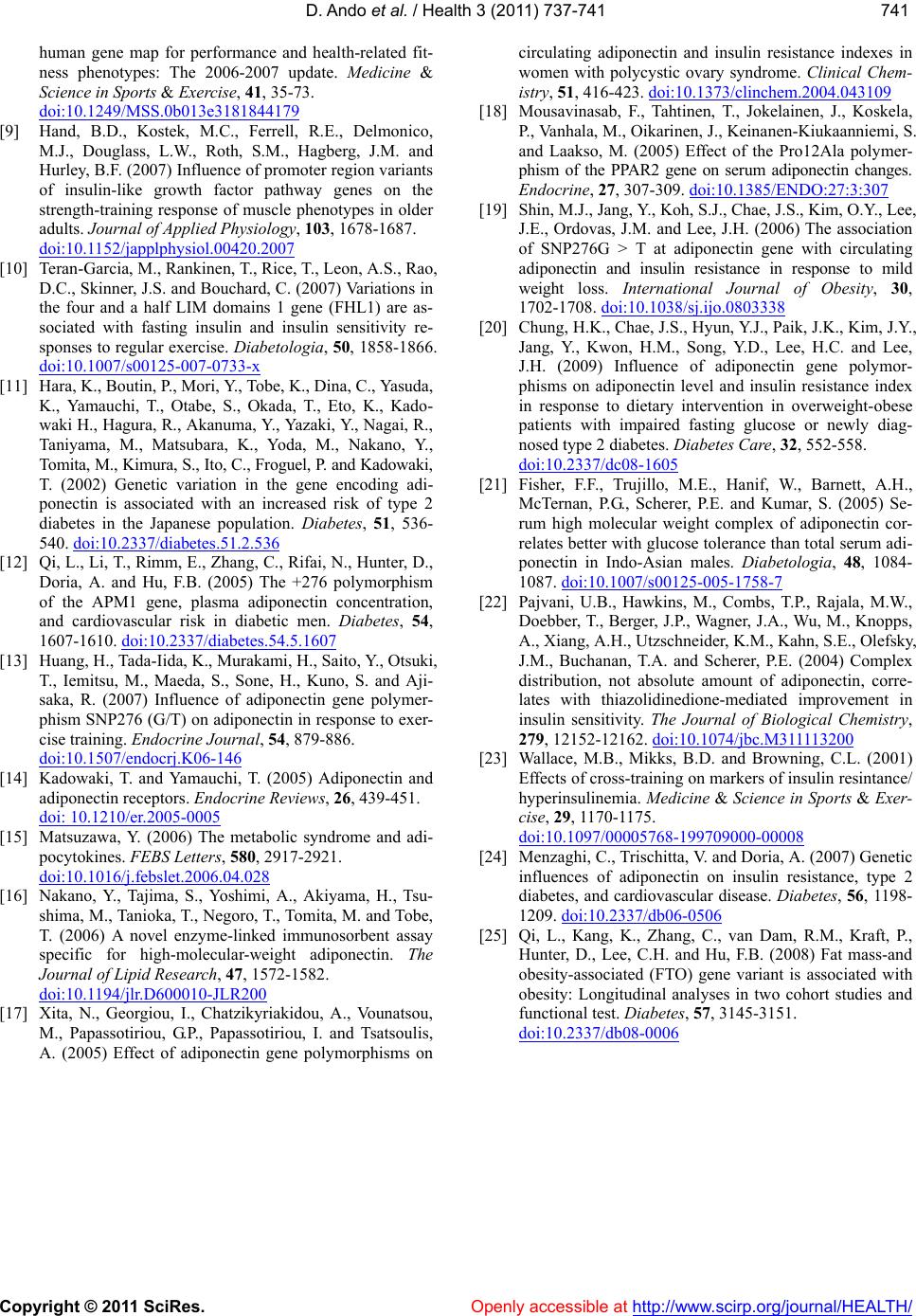 D. Ando et al. / Health 3 (2011) 737-741 Copyright © 2011 SciRes. Openly accessible at http:// www.scirp.org/journal/HEALTH/ 741741 human gene map for performance and health-related fit- ness phenotypes: The 2006-2007 update. Medicine & Science in Sports & Exercise, 41, 35-73. doi:10.1249/MSS.0b013e3181844179 [9] Hand, B.D., Kostek, M.C., Ferrell, R.E., Delmonico, M.J., Douglass, L.W., Roth, S.M., Hagberg, J.M. and Hurley, B.F. (2007) Influence of promoter region variants of insulin-like growth factor pathway genes on the strength-training response of muscle phenotypes in older adults. Journal of Applied Physiology, 103, 1678-1687. doi:10.1152/japplphysiol.00420.2007 [10] Teran-Garcia, M., Rankinen, T., Rice, T., Leon, A.S., Rao, D.C., Skinner, J.S. and Bouchard, C. (2007) Variations in the four and a half LIM domains 1 gene (FHL1) are as- sociated with fasting insulin and insulin sensitivity re- sponses to regular exercise. Diabetologia, 50, 1858-1866. doi:10.1007/s00125-007-0733-x [11] Hara, K., Boutin, P., Mori, Y., Tobe, K., Dina, C., Yasuda, K., Yamauchi, T., Otabe, S., Okada, T., Eto, K., Kado- waki H., Hagura, R., Akanuma, Y., Yazaki, Y., Nagai, R., Taniyama, M., Matsubara, K., Yoda, M., Nakano, Y., Tomita, M., Kimura, S., Ito, C., Froguel, P. and Kadowaki, T. (2002) Genetic variation in the gene encoding adi- ponectin is associated with an increased risk of type 2 diabetes in the Japanese population. Diabetes, 51, 536- 540. doi:10.2337/diabetes.51.2.536 [12] Qi, L., Li, T., Rimm, E ., Zhang, C., Rifai, N., Hunter, D., Doria, A. and Hu, F.B. (2005) The +276 polymorphism of the APM1 gene, plasma adiponectin concentration, and cardiovascular risk in diabetic men. Diabetes, 54, 1607-1610. doi:10.2337/diabetes.54.5.1607 [13] Huang, H., Tada-Iida, K., Murakami, H., Sai to, Y., Ot suki, T., Iemitsu, M., Maeda, S., Sone, H., Kuno, S. and Aji- saka, R. (2007) Influence of adiponectin gene polymer- phism SNP276 (G/T) on adiponectin in response to exer- cise training. Endocrine Journal, 54, 879-886. doi:10.1507/endocrj.K06-146 [14] Kadowaki, T. and Yamauchi, T. (2005) Adiponectin and adiponectin receptors. Endocrine Reviews, 26, 439-451. doi: 10.1210/er.2005-0005 [15] Matsuzawa, Y. (2006) The metabolic syndrome and adi- pocytokines. FEBS Letters, 580, 2917-2921. doi:10.1016/j.febslet.2006.04.028 [16] Nakano, Y., Tajima, S., Yoshimi, A., Akiyama, H., Tsu- shima, M., Tanioka, T., Negoro, T., Tomita, M. and Tobe, T. (2006) A novel enzyme-linked immunosorbent assay specific for high-molecular-weight adiponectin. The Journal of Lipid Research, 47, 1572-1582. doi:10.1194/jlr.D600010-JLR200 [17] Xita, N., Georgiou, I., Chatzikyriakidou, A., Vounatsou, M., Papassotiriou, G.P., Papassotiriou, I. and Tsatsoulis, A. (2005) Effect of adiponectin gene polymorphisms on circulating adiponectin and insulin resistance indexes in women with polycystic ovary syndrome. Clinical Chem- istry, 51, 416-423. doi:10.1373/clinchem.2004.043109 [18] Mousavinasab, F., Tahtinen, T., Jokelainen, J., Koskela, P., Vanhala, M., Oikarinen, J., Keinanen-Kiukaanniemi, S. and Laakso, M. (2005) Effect of the Pro12Ala polymer- phism of the PPAR2 gene on serum adiponectin changes. Endocrine, 27, 307-309. doi:10.1385/ENDO:27:3:307 [19] Shin, M.J., Jang, Y., Koh, S.J., Chae, J.S., Kim, O.Y., Lee, J.E., Ordovas, J.M. and Lee, J.H. (2006) The association of SNP276G > T at adiponectin gene with circulating adiponectin and insulin resistance in response to mild weight loss. International Journal of Obesity, 30, 1702-1708. doi:10.1038/sj.ijo.0803338 [20] Chung, H.K., Chae, J.S., Hyun, Y.J., Paik, J.K., Kim, J.Y., Jang, Y., Kwon, H.M., Song, Y.D., Lee, H.C. and Lee, J.H. (2009) Influence of adiponectin gene polymor- phisms on adiponectin level and insulin resistance index in response to dietary intervention in overweight-obese patients with impaired fasting glucose or newly diag- nosed type 2 diabetes. Diabetes Care, 32, 552-558. doi:10.2337/dc08-1605 [21] Fisher, F.F., Trujillo, M.E., Hanif, W., Barnett, A.H., McTernan, P.G., Scherer, P.E. and Kumar, S. (2005) Se- rum high molecular weight complex of adiponectin cor- relates better with glucose tolerance than total serum adi- ponectin in Indo-Asian males. Diabetologia, 48, 1084- 1087. doi:10.1007/s00125-005-1758-7 [22] Pajvani, U.B., Hawkins, M., Combs, T.P., Rajala, M.W., Doebber, T., Berger, J.P., Wagner, J.A., Wu, M., Knopps, A., Xiang, A.H., Utzschneider, K.M., Kahn, S.E., Olefsky, J.M., Buchanan, T.A. and Scherer, P.E. (2004) Complex distribution, not absolute amount of adiponectin, corre- lates with thiazolidinedione-mediated improvement in insulin sensitivity. The Journal of Biological Chemistry, 279, 12152-12162. doi:10.1074/jbc.M311113200 [23] Wallace, M.B., Mikks, B.D. and Browning, C.L. (2001) Effects of cross-training on markers of insulin resintance/ hyperinsulinemia. Medicine & Science in Sports & Exer- cise, 29, 1170-1175. doi:10.1097/00005768-199709000-00008 [24] Menzaghi, C., Trischitta, V. and Doria, A. (2007) Genetic influences of adiponectin on insulin resistance, type 2 diabetes, and cardiovascular disease. Diabetes, 56, 1198- 1209. doi:10.2337/db06-0506 [25] Qi, L., Kang, K., Zhang, C., van Dam, R.M., Kraft, P., Hunter, D., Lee, C.H. and Hu, F.B. (2008) Fat mass-and obesity-associated (FTO) gene variant is associated with obesity: Longitudinal analyses in two cohort studies and functional test. Diabetes, 57, 3145-3151. doi:10.2337/db08-0006
|